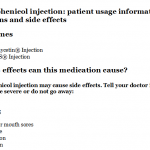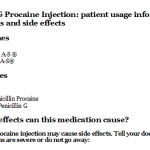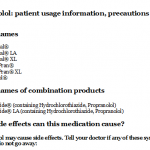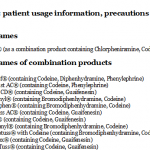
Meningococcal (Menactra) Polysaccharide Diphtheria Toxoid Conjugate Vaccine: patient information, prescribing information, ingredients, manufacturer, adverse reactions and side effects
Friday, April 07, 2017 by Gregory Van Dyke
http://www.naturalnewsreference.com/2017-04-07-meningococcal-menactra-polysaccharide-diphtheria-toxoid-conjugate-vaccine-patient-information-prescribing-information-ingredients-manufacturer-adverse-reactions-and-side-effects.html
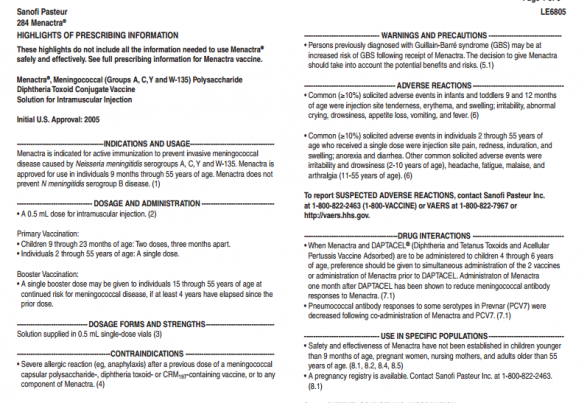
HIGHLIGHTS OF PRESCRIBING INFORMATION
These highlights do not include all the information needed to use Menactra® safely and effectively. See full prescribing information for Menactra vaccine.
See full insert sheet at this link at the Natural News Reference website.
Menactra®, Meningococcal (Groups A, C, Y and W-135) Polysaccharide
Diphtheria Toxoid Conjugate Vaccine
Solution for Intramuscular Injection
Initial U.S. Approval: 2005
INGREDIENTS AND EXCIPIENTS
Menactra is a sterile, intramuscularly administered vaccine that contains N meningitidis serogroup A, C, Y and W-135 capsular polysaccharide antigens individually conjugated to diphtheria toxoid protein. N meningitidis A, C, Y and W-135 strains are cultured on Mueller Hinton agar (3) and grown in Watson Scherp (4) media containing casamino acid. The polysaccharides are extracted from the N meningitidis cells and purified by centrifugation, detergent precipitation, alcohol precipitation, solvent extraction and diafiltration. To prepare the polysaccharides for conjugation, they are depolymerized, derivatized, and purified by diafiltration. Diphtheria toxin is derived from Corynebacterium diphtheriae grown in modified culture medium containing hydrolyzed casein (5) and is detoxified using formaldehyde. The diphtheria toxoid protein is purified by ammonium sulfate fractionation and diafiltration. The derivatized polysaccharides are covalently linked to diphtheria toxoid and purified by serial diafiltration. The four meningococcal components, present as individual serogroup-specific glycoconjugates, compose the final formulated vaccine. No preservative or adjuvant is added during manufacture. Each 0.5 mL dose may contain residual amounts of formaldehyde of less than 2.66 mcg (0.000532%), by calculation. Potency of Menactra is determined by quantifying the amount of each polysaccharide antigen that is conjugated to diphtheria toxoid protein and the amount of unconjugated polysaccharide present.
Menactra is manufactured as a sterile, clear to slightly turbid liquid. Each 0.5 mL dose of vaccine is formulated in sodium phosphate buffered isotonic sodium chloride solution to contain 4 mcg each of meningococcal A, C, Y and W-135 polysaccharides conjugated to approximately 48 mcg of diphtheria toxoid protein carrier.
The vial stopper is not made with natural rubber latex.
INDICATIONS AND USAGE
Menactra is indicated for active immunization to prevent invasive meningococcal disease caused by Neisseria meningitidis serogroups A, C, Y and W-135. Menactra is approved for use in individuals 9 months through 55 years of age. Menactra does not prevent N meningitidis serogroup B disease. (1)
DOSAGE AND ADMINISTRATION
• A 0.5 mL dose for intramuscular injection. (2)
Primary Vaccination:
• Children 9 through 23 months of age: Two doses, three months apart.
• Individuals 2 through 55 years of age: A single dose.
Booster Vaccination:
• A single booster dose may be given to individuals 15 through 55 years of age at
continued risk for meningococcal disease, if at least 4 years have elapsed since the
prior dose.
DOSAGE FORMS AND STRENGTHS
Solution supplied in 0.5 mL single-dose vials (3)
CONTRAINDICATIONS
Severe allergic reaction (eg, anaphylaxis) after a previous dose of a meningococcal capsular polysaccharide-, diphtheria toxoid- or CRM197-containing vaccine, or to any component of Menactra. (4)
WARNINGS AND PRECAUTIONS
Persons previously diagnosed with Guillain-Barré syndrome (GBS) may be at increased risk of GBS following receipt of Menactra. The decision to give Menactra should take into account the potential benefits and risks. (5.1)
ADVERSE REACTIONS
Common (≥10%) solicited adverse events in infants and toddlers 9 and 12 months of age were injection site tenderness, erythema, and swelling; irritability, abnormal crying, drowsiness, appetite loss, vomiting, and fever. (6)
Common (≥10%) solicited adverse events in individuals 2 through 55 years of age who received a single dose were injection site pain, redness, induration, and swelling; anorexia and diarrhea. Other common solicited adverse events were irritability and drowsiness (2-10 years of age), headache, fatigue, malaise, and arthralgia (11-55 years of age). (6)
To report SUSPECTED ADVERSE REACTIONS, contact Sanofi Pasteur Inc. at 1-800-822-2463 (1-800-VACCINE) or VAERS at 1-800-822-7967 or http://vaers.hhs.gov.
DRUG INTERACTIONS
When Menactra and DAPTACEL® (Diphtheria and Tetanus Toxoids and Acellular Pertussis Vaccine Adsorbed) are to be administered to children 4 through 6 years of age, preference should be given to simultaneous administration of the 2 vaccines or administration of Menactra prior to DAPTACEL. Administraton of Menactra one month after DAPTACEL has been shown to reduce meningococcal antibody responses to Menactra. (7.1)
Pneumococcal antibody responses to some serotypes in Prevnar (PCV7) were decreased following co-administration of Menactra and PCV7. (7.1)
USE IN SPECIFIC POPULATIONS
Pregnancy
Pregnancy Exposure Registry
There is a pregnancy exposure registry that monitors pregnancy outcomes in women exposed to Menactra during pregnancy. To enroll in or obtain information about the registry, call Sanofi Pasteur at 1-800-822-2463.
Risk Summary
All pregnancies have a risk of birth defect, loss, or other adverse outcomes. In the US general population, the estimated background risk of major birth defects and miscarriage in clinically recognized pregnancies is 2% to 4% and 15% to 20%, respectively. There are no adequate and well-controlled studies of Menactra administration in pregnant women in the US. Available data suggest that rates of major birth defects and miscarriage in women who received Menactra 30 days prior to pregnancy or during pregnancy are consistent with estimated background rates.
A developmental toxicity study was performed in female mice given 0.1 mL (in divided doses) of Menactra prior to mating and during gestation (a single human dose is 0.5 mL). The study revealed no evidence of harm to the fetus due to Menactra [see Animal Data (8.1)].
Data
Human Data
A pregnancy registry spanning 11 years (2005-2016) included 222 reports of exposure to Menactra from 30 days before or at any time during pregnancy. Of these reports, 87 had known pregnancy outcomes available and were enrolled in the pregnancy registry prior to the outcomes being known. Outcomes among these prospectively followed pregnancies included 2 major birth defects and 6 miscarriages.
Animal Data
A developmental toxicity study was performed in female mice. The animals were administered 0.1 mL of Menactra (in divided doses) at each of the following time points: 14 days prior to mating, and on Days 6 and 18 of gestation (a single human dose is 0.5 mL). There were no vaccine-related fetal malformations or variations, and no adverse effects on pre-weaning development observed in the study.
Lactation
Risk Summary
The developmental and health benefits of breastfeeding should be considered along with the mother’s clinical need for Menactra and any potential adverse effects on the breastfed child from Menactra. Data are not available to assess the effects of Menactra on the breastfed infant or on milk production/excretion.
Pediatric Use
Menactra is not approved for use in infants under 9 months of age. Available data show that infants administered three doses of Menactra (at 2, 4, and 6 months of age) had diminished responses to each meningococcal vaccine serogroup compared to older children given two doses at 9 and 12 months of age.
Geriatric Use
Safety and effectiveness of Menactra in adults older than 55 years of age have not been established.
Safety and effectiveness of Menactra have not been established in children younger than 9 months of age, pregnant women, nursing mothers, and adults older than 55 years of age. (8.1, 8.2, 8.4, 8.5)
A pregnancy registry is available. Contact Sanofi Pasteur Inc. at 1-800-822-2463. (8.1)
Revised: September 2016
https://www.vaccineshoppe.com/image.cfm?doc_id=12580&image_type=product_pdf
Tagged Under: Tags: dosage, ingredients, insert sheet, menactra, side effects, usage, warnings

